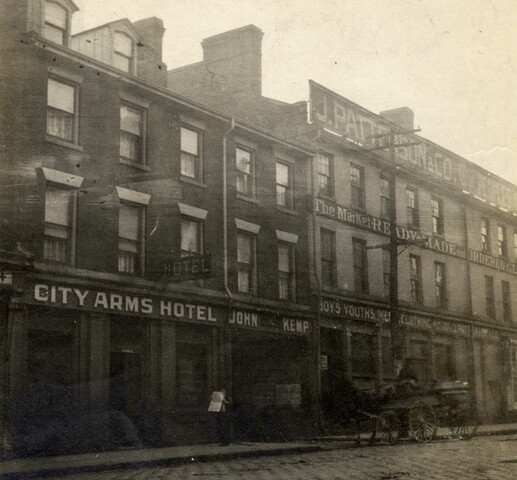
Market Street
87 Front Street, 8 Market Street, 10-12 Market Street
Market Street, west side, looking north to south of King St. E., 1911. Image: Toronto Public Library
Market Street, Toronto, 2014. Image: Taylor Smyth Architects
Market Street, Toronto, c. 2014. Image: Taylor Smyth Architects
87 Front Street, 8 Market Street, 10-12 Market Street
Developer: Woodcliffe Landmark Properties
Architects: Taylor Smyth Architects and GBCA Architects
Market Street is one of Toronto’s oldest main roads. Thanks to an extensive revitalization project, which won a 2014 Heritage Toronto Award of Excellence, Market Street has been revived through the restoration of three, mid-to-late nineteenth-century heritage buildings.
The building at 87 Front Street, built in 1858 in the heart of the St. Lawrence Market neighbourhood, was designed in the Georgian Revival style for the Edward Leadley Company, which traded in wool, hides, skins and tallow. Around the corner at 10-12 Market Street, the Armory Hotel was built in 1880 for William Cayley, a lawyer, financier and provincial politician. The two-storey building features elaborate detailing inspired by Italianate design.
Architect A.R. Denison designed the John Hallam Warehouse at 8 Market Street in 1900, just south of the Armory Hotel, featuring Romanesque Revival elements, completed with red brick cladding and brick and stone detailing. A. R. Denison’s (1857-1923) work included the prominent commission to oversee extensive alterations to South St. Lawrence Market, including an archway over Front Street connecting the north and south market buildings. He prepared the plans for the John Hallam Warehouse across the street the next year, repeating the round-arched motif from the market complex on Hallam’s building.
Over the course of a decade, under the leadership of Paul Oberman, Woodcliffe Landmark Properties acquired these three buildings and embarked on an ambitious plan to reinvent the street. In addition to restoring the heritage buildings and adding retail spaces, public realm and street improvements were implemented and set new standards. The heritage buildings received new mechanical and electrical systems, and, in many cases, new flooring. Woodcliffe also installed new storm and sanitary sewers, water and gas lines.
To stabilize the second storey brick façade of the Armory Hotel, it was completed rebuilt, including replication of wood windows and a brick parapet, and the recreation of a missing wood cornice. Outer bricks were rotated so the fresh inner face of the brick was shown, and replacement bricks were ordered from the UK, as no company in Canada made ones that matched the style and colour. As part of the complex’s redevelopment, an internal corridor was built along the rear of the buildings with access to a loading zone and garbage storage area, preventing the use of Market Street as a loading area. Woodcliffe also rebuilt and waterproofed the stone foundation of 87 Front Street.
